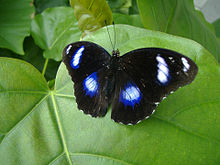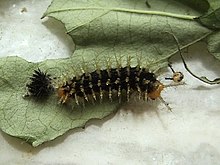Hypolimnas bolina
| Hypolimnas bolina | ||||||||||||
|---|---|---|---|---|---|---|---|---|---|---|---|---|

Hypolimnas bolina |
||||||||||||
| Systematics | ||||||||||||
|
||||||||||||
| Scientific name | ||||||||||||
| Hypolimnas bolina | ||||||||||||
| ( Linnaeus , 1758) |
The Hypolimnas bolina , sometimes referred to as the common eggfly, analogous to the common eggfly, is a tropical butterfly ( butterfly ) from the noble butterfly family (Nymphalidae).
features
The moths reach a wingspan of 65 to 95 millimeters. The two sexes are colored very differently ( sexual dichroism ). The upper sides of the forewings have a black base color in the females. They have four to five small, closely spaced white spots on their wing tips. Further inside you can see a white band that leads diagonally from the wing leading edge to the outer edge. Like the white spots on the wing tip, this band is interrupted by the black wing veins . Parallel to this band runs from the inner edge of the wing to about the middle of the wing, an elongated, orange spot, the edge of which runs diffusely with the black. Two rows of fine white spots in pairs run along the outer edge of the wing. In addition, there are other fine white spots running parallel to the outer edge. The hind wings, the edge of which is slightly wavy, also have a black basic color. In the middle a light, slightly yellowish spot can be seen, which is brownish or bluish in color towards the outer edge.
The males also have a basic black color on the upper sides of the wings. On the forewings, near the wing tip, there is a white spot and further inside another, larger and elongated white spot. This is more or less strongly surrounded with blue shimmering scales . In the middle of the hind wings the males each have a further, large and round white spot, which is clearly surrounded by blue scales. The blue can dominate here, so that very little of the white color can be seen.
The wing undersides of both sexes are colored the same and resemble the coloring of the female wing upper sides. The basic color is brown instead of black. The white spots on the upper side can be found on the forewings, only those on the outer edge of the wing and those parallel to it further inside are more pronounced. There are also white spots along the wing leading edge from the base to about the middle. The orange spot has a brownish discoloration and is even more diffuse along the entire length of the inner edge. The hind wings have a dominant yellowish to white band that runs from the middle of the wing leading edge to about the middle of the inner edge. It is also interrupted by the brown vein. Three differently shaped rows of white spots run along the outer edge. Directly on the edge they are crescent-shaped, adapted to the wavy edge, further inside there are broad arc spots and finally inside a series of round, small dots.
The body of the moth is black on the upper side and brown on the underside.
Characteristics of the caterpillars
The caterpillars are black in color, their head and the last segment are orange. They have two antennae-like appendages on their heads that are colored black. The body is covered with numerous, long and branched black-orange thorns. These are still transparent and light after molting. In older caterpillars, the trachea have a dirty orange border.
Similar species
Subspecies
The species Hypolimnas bolina is divided into eight subspecies:
- Hypolimnas bolina bolina
- Hypolimnas bolina nerina
- Hypolimnas bolina montrouzieri
- Hypolimnas bolina pulchra
- Hypolimnas bolina pallescens
- Hypolimnas bolina lisianassa
- Hypolimnas bolina jacintha
- Hypolimnas bolina kezia
Occurrence
The distribution area of the animals extends over Australasia and the Indomalayis ( India and Southeast Asia ), but they also come in the eastern areas of the Afrotropic , such as. B. in Yemen , Oman and Madagascar . They are common and live in deciduous forests and heavily bushed, moist terrain. But you can also find them in parks and gardens.
Way of life
Food of the caterpillars
The caterpillars feed on a multitude of different plants from the families of the acanthus plants (Acanthaceae), bindweed plants (Convolvulaceae), mallow plants (Malvaceae) and nettle plants (Urticaceae).
development
The females usually lay the eggs individually, sometimes in groups of up to five, on the underside of the leaves of their forage plants. Before doing this, it is checked whether the plant is free of ants that could eat the eggs. Even after the eggs are laid, the moths guard the clutch. The eggs are pale green and slightly transparent and have longitudinal grooves on the sides. The caterpillars hatch after about four days and live solitary from the start. Pupation takes place in tumbled pupae . These are gray-brown in color and have pointed extensions.
Exclusively male crawler can Wolbachia - bacteria are attacked and die thereby. However, scientists have observed on two island populations that the large egg fly has developed a protective mechanism against the bacteria within a few years. They suspect that a newly developed gene inhibits the formation of bacteria, as a result of which the proportion of male adult butterflies there rose from just 1% in 2001 to 40% in 2006. This would be one of the fastest evolutionary developments ever observed.
Web links
Individual evidence
- ↑ BBC News: Butterfly shows evolution at work, July 12, 2007.



